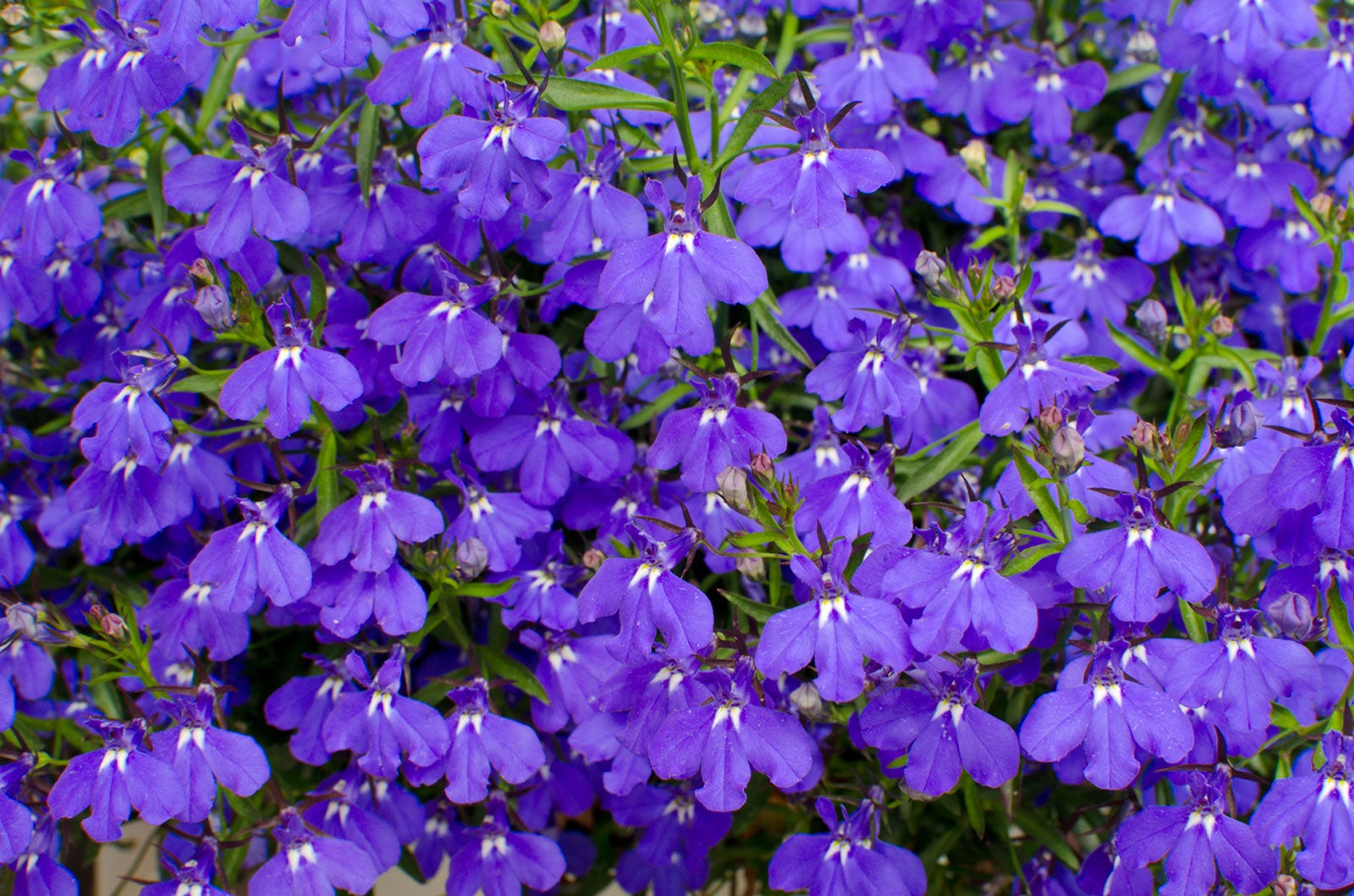Plant Lobelia in well-drained soil and provide partial shade. Water regularly to keep the soil consistently moist.
Lobelia is a vibrant and versatile plant, perfect for gardens and containers. Known for its striking blue, purple, and white flowers, Lobelia adds a splash of color to any landscape. This low-maintenance plant thrives in cooler climates, making it an excellent choice for early spring or fall gardening.
It attracts pollinators like bees and butterflies, enhancing the ecological value of your garden. To ensure healthy growth, choose a spot with partial shade and well-drained soil. Regular watering is essential to keep the soil consistently moist, promoting lush blooms. With minimal effort, you can enjoy the beauty and benefits of Lobelia in your garden.
Choosing The Right Lobelia Variety
Choosing the right Lobelia variety is key to a thriving garden. Lobelias come in many types, each with unique traits. Knowing the differences helps ensure success.
Annual Vs Perennial
Annual Lobelias bloom for one season. They bring vibrant colors to summer gardens. These varieties are perfect for borders and containers.
Perennial Lobelias return year after year. They require less replanting. Perennials are ideal for long-term garden plans.
Popular Varieties
There are many Lobelia varieties. Here are some popular choices:
- Lobelia erinus: Known for its blue flowers. Perfect for hanging baskets.
- Lobelia cardinalis: Features striking red blooms. Attracts hummingbirds.
- Lobelia siphilitica: Offers tall, blue flower spikes. Great for wet areas.
- Lobelia speciosa: A hybrid with mixed colors. Ideal for garden beds.
Below is a table summarizing the key differences:
| Variety | Type | Color | Best Use |
|---|---|---|---|
| Lobelia erinus | Annual | Blue | Hanging Baskets |
| Lobelia cardinalis | Perennial | Red | Attracting Hummingbirds |
| Lobelia siphilitica | Perennial | Blue | Wet Areas |
| Lobelia speciosa | Hybrid | Mixed | Garden Beds |

Credit: gardenerspath.com
Ideal Growing Conditions
For vibrant and healthy Lobelia, knowing the ideal growing conditions is key. Lobelia thrives in specific environments. Understanding these conditions can make your gardening efforts successful.
Sunlight Requirements
Lobelia prefers partial shade to full sun. Too much sunlight can scorch the leaves. Aim for at least 4-6 hours of sunlight each day.
In hotter climates, provide afternoon shade. This prevents the plant from overheating. A spot with morning sun and afternoon shade works best.
Soil Preferences
Lobelia enjoys moist, well-draining soil. The soil should be rich in organic matter. Compost or well-rotted manure can improve soil quality.
Here’s a simple soil mix you can use:
- 1 part garden soil
- 1 part compost
- 1 part peat moss or coconut coir
Maintain soil pH between 6.0 and 7.0. A pH test kit can help you check the levels.
| Soil Type | Moisture Level | pH Range |
|---|---|---|
| Well-draining | Moist | 6.0 – 7.0 |
Regular watering is essential, especially during dry spells. The soil should never dry out completely. Water deeply but avoid waterlogging.
Planting Lobelia
Growing Lobelia can be a rewarding experience for gardeners. This beautiful plant can add vibrant color to any garden. Let’s dive into the details of planting Lobelia.
When To Plant
Plant Lobelia after the last frost. Wait until the soil is warm. Typically, this is in late spring. You can start seeds indoors six weeks before the last frost.
Spacing And Depth
Proper spacing is crucial for healthy Lobelia growth.
| Spacing | Depth |
|---|---|
| 6 to 12 inches apart | 1/8 inch deep |
Plant seeds in well-draining soil. Cover them lightly with soil. Water gently to keep the soil moist. Ensure you do not overwater.
Follow these steps to plant Lobelia successfully. Enjoy the vibrant blooms in your garden!
Watering And Fertilizing
Proper watering and fertilizing are crucial for growing healthy lobelia. This guide will help you keep your lobelia plants vibrant and blooming throughout the growing season.
Watering Schedule
Lobelia plants need regular watering to thrive. They prefer moist soil, but it should not be waterlogged. The watering schedule depends on the weather and soil type.
- Daily watering during hot, dry periods.
- Every other day in cooler, wetter weather.
- Morning watering is best to avoid fungal issues.
Check the soil moisture by touching it. If the top inch is dry, it’s time to water. Use a gentle spray to avoid damaging the plants.
Best Fertilizers
Lobelia plants benefit from regular fertilizing. Choose the right fertilizer to ensure robust growth and vibrant blooms.
| Fertilizer Type | Benefits | Application Frequency |
|---|---|---|
| Balanced Liquid Fertilizer | Promotes overall health and growth | Every 2 weeks |
| Slow-Release Granules | Provides nutrients over time | Once a month |
| Organic Compost | Improves soil structure | Every 6 weeks |
Follow the instructions on the fertilizer packaging. Over-fertilizing can harm your plants, so be cautious.
Pruning And Deadheading
Pruning and deadheading are vital tasks for growing healthy lobelia. These practices ensure your plants stay vibrant and bloom continuously. Proper pruning and deadheading can make a big difference in your garden’s appearance.
When To Prune
Knowing when to prune your lobelia is crucial. Prune your lobelia in early spring. This helps remove any dead or damaged stems. Pruning in early spring promotes new growth.
- Prune after the last frost.
- Check for dead or damaged stems.
- Remove any diseased parts.
How To Deadhead
Deadheading keeps your lobelia blooming all season. Remove spent flowers to encourage new blooms. Follow these simple steps to deadhead your lobelia:
- Use sharp scissors or pruners.
- Cut the stem just above a leaf or bud.
- Dispose of the removed flowers properly.
Deadheading is a simple task. Repeat it regularly for best results.
| Task | Timing |
|---|---|
| Prune | Early Spring |
| Deadhead | Throughout Bloom Season |

Credit: www.gardenersworld.com
Pest And Disease Management
Managing pests and diseases is crucial for growing healthy lobelia plants. Proper care and attention can prevent infestations and infections, ensuring your lobelia thrives.
Common Pests
Several pests can attack lobelia plants. Here are the most common ones:
- Aphids: These small insects can suck the sap from leaves.
- Spider Mites: These tiny bugs cause yellow spots on leaves.
- Slugs and Snails: These pests chew holes in leaves.
To manage these pests, you can use natural predators like ladybugs for aphids and neem oil for spider mites. For slugs and snails, you can set up traps or handpick them early in the morning or late evening.
Disease Prevention
Lobelia plants can be susceptible to various diseases. Here are some tips to prevent them:
- Choose Resistant Varieties: Some lobelia varieties are resistant to diseases.
- Proper Watering: Water the base, not the leaves, to prevent fungal growth.
- Good Air Circulation: Space plants adequately to allow air to circulate.
- Clean Tools: Always use clean gardening tools to prevent disease spread.
By following these steps, you can keep your lobelia plants healthy and vibrant.
Overwintering Lobelia
Overwintering Lobelia ensures your beautiful plants survive the cold months. Proper care during winter can keep your Lobelia healthy and ready to bloom in spring.
Indoor Care
Bringing Lobelia indoors during winter can protect it from frost. Follow these steps to keep your Lobelia thriving indoors:
- Choose a bright spot: Place your Lobelia near a sunny window.
- Water sparingly: Water only when the soil feels dry.
- Maintain humidity: Use a humidifier or mist the leaves daily.
- Check for pests: Regularly inspect for insects and remove them.
Outdoor Protection
For those who cannot bring their Lobelia indoors, outdoor protection is crucial. Here are some tips to help your Lobelia survive outside:
- Mulch the soil: Add a thick layer of mulch around the base.
- Cover with a cloche: Use a garden cloche to shield from frost.
- Prune dead parts: Trim any dead or damaged leaves.
- Water occasionally: Keep the soil moist but not soggy.
Here is a quick comparison of Indoor Care and Outdoor Protection:
| Indoor Care | Outdoor Protection |
|---|---|
| Bright spot | Mulch soil |
| Water sparingly | Cover with cloche |
| Maintain humidity | Prune dead parts |
| Check for pests | Water occasionally |

Credit: www.gardeningknowhow.com
Companion Planting
Growing lobelia can be rewarding for any garden enthusiast. One effective method to boost their growth is through companion planting. This technique involves planting lobelia alongside other plants that benefit each other. It helps in improving soil health, deterring pests, and increasing overall garden productivity.
Best Companions
Choosing the right companions for lobelia can enhance their growth. Here are some of the best plants to pair with lobelia:
- Marigolds: Repel harmful insects and attract beneficial ones.
- Petunias: Similar growing conditions and attract pollinators.
- Nasturtiums: Attract aphids away from lobelia, acting as a trap crop.
- Sweet Alyssum: Attracts beneficial insects like hoverflies and predatory wasps.
Avoiding Competition
While companion planting is beneficial, it’s crucial to avoid competition. Certain plants can hinder lobelia’s growth by competing for nutrients, water, and sunlight.
| Plants to Avoid | Reason |
|---|---|
| Sunflowers | They can overshadow lobelia, blocking sunlight. |
| Large Shrubs | They compete for water and nutrients. |
| Dense Ground Covers | They take up space and resources. |
Spacing is also important to avoid competition. Ensure there is enough space between lobelia and other plants. This ensures that each plant gets sufficient resources.
Follow these tips to achieve a thriving lobelia garden. Happy gardening!
Frequently Asked Questions
How Do You Plant Lobelia Seeds?
Plant Lobelia seeds indoors 8-10 weeks before the last frost. Sow them on the surface and press lightly. Keep the soil moist.
What Is The Best Soil For Lobelia?
Lobelia thrives in well-drained, rich, and moist soil. A slightly acidic pH is preferred for optimal growth.
How Often Should I Water Lobelia?
Water Lobelia regularly to keep the soil consistently moist. Avoid overwatering, but don’t let the soil dry out completely.
Can Lobelia Grow In Full Sun?
Lobelia grows best in partial shade but can tolerate full sun in cooler climates. Avoid intense afternoon sun.
Conclusion
Growing lobelia can transform your garden with vibrant colors. Follow these tips for healthy and thriving plants. Regular watering, proper sunlight, and suitable soil are key. With care, your lobelia will flourish beautifully. Happy gardening!
